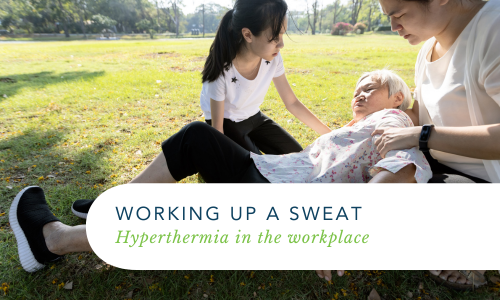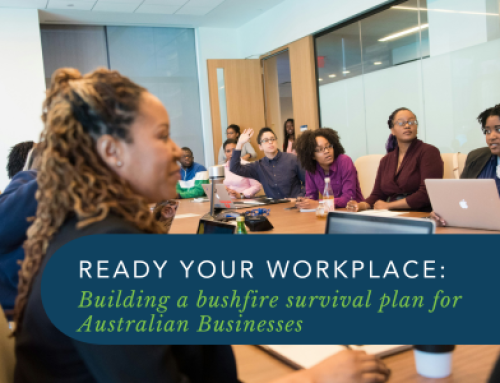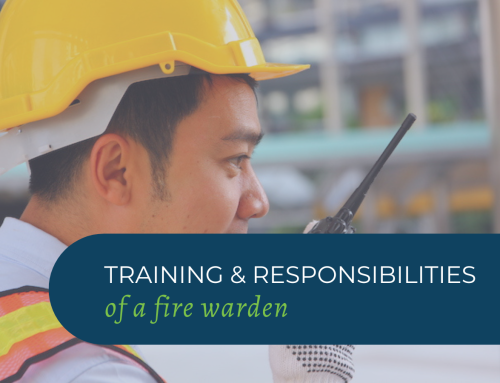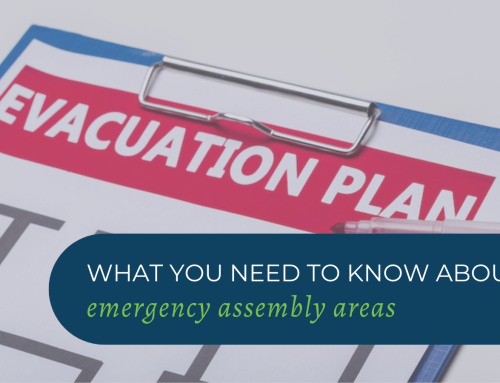Working up a Sweat!
Not everyone is fortunate enough to carry out their workday in a climate-controlled environment and not everyone wants to. While working outdoors often comes with benefits of fresh air, nice views, feeling the sun on your face, there are also situations that we need to be aware of, have strategies for and plans in place, such as hyperthermia. Business owners have an obligation to assess working environments and conditions and do what ever is practicable to ensure workers are safe and remain healthy.
What is hyperthermia?
Hyperthermia is the term that refers to several conditions that can occur when your body’s heat-regulation system can’t handle the increased temperature in your environment.
Our body is like the 3 bears from Goldilocks – not too hot, not too cold but just right. Our body is happy when we are around 37°C. It’s not happy is we drop to 35°C or climb to 40°C.
Large areas of Australia are quite warm year-round, but summer temperatures increase across the country. Temperature, humidity, wind, the amount of solar radiation, what you’re doing and what you are wearing are all factors that can contribute to overheating.
Construction workers, farmers, gardeners/ landscapers, warehouse employees, people doing physical jobs are most at risk of overheating, especially in summer.
In Australia over the past decade, heat has killed close to 300 people and hospitalised more than 7000, but experts believe these numbers are underestimated.
How does heat affect our body?
When our temperature rises, to protect itself, our body tries to keep warm blood away from our internal organs and redirects it to your skin, giving that pink, or red, flushed appearance. Sweat is released from our sweat glands, which is evaporated from our skin, cooling our body down.
Some medications can also have an effect on how our body behaves when it’s hot. Some blood pressure medications & diuretics (fluid tablets) can affect a person’s ability to sweat adequately, due to less fluid retained by the body.
Humid days can be particularly dangerous. Sweating becomes ineffective as a cooling technique when the air is saturated, because it can’t evaporate from your skin as effectively. This is why it is so important to ensure that plenty of water & fluids are available to prevent dehydration. If you don’t have enough fluid going in to replace what is being sweated out, this way of cooling our bodies stops working.
Heat & loss of fluids can also cause our heart to overwork. It has to work harder to maintain Blood Pressure as there is less volume to pump around the body & reach essential organs. If it drops too low, it can cause cardiac arrest.
Even small increases in temperature for short periods of time can also affect our brain and mood. Heat can disrupt communication between nerve cells which can lead to irritability or impaired judgement.
Signs & symptoms
There are 3 stages to hyperthermia and obviously, we want to recognise the signs early, before they get to a critical level & require medical intervention.
Early stages of hyperthermia can include:
- dizziness
- weakness
- nausea
- thirst
- a headache
This can progress to cramps & fainting if we fail to recognise and take action on these signs and symptoms.
Heat exhaustion
This is one of the most serious stages of hyperthermia. Heat exhaustion occurs when your body can’t cool itself anymore.
In addition to sweating profusely, you may experience:
- dizziness
- weakness
- thirst
- coordination issues
- trouble concentrating
- skin that’s cool and clammy
- rapid pulse
This is the last stage before heat stroke occurs, so it’s important that you rest and rehydrate as soon as you feel symptoms developing.
Heat Stroke/ Stress
When your core temperature gets to about 41 °C, your body essentially starts to cook from the inside. Damage is occurring to muscles, blood vessels & major organs such as the heart & kidneys.
- It is no longer able to produce sweat due to dehydration.
- The skin will no longer be clammy & cool, it will be red & hot
- Breathing will be laboured, as the heart is unable to transport oxygen around the body efficiently
- Confusion due to lack of oxygen to the brain & toxins now being transported around the body
- Unconsciousness
- Cardiac arrest
First Aid for hyperthermia
In the early stages, get the person to stop what they are doing
- Sit them down in a shaded place
- Give them cool water to drink
- Remove excess clothing and loosen remaining clothing
- Monitor & reassess as necessary
Heat exhaustion
This is the last stage before heat stroke occurs, so it’s important that rest and rehydration happens as soon as they feel symptoms developing.
- Move the person into a cool, shaded area
- Offer sips of fluid. Electrolyte fluids if you have them or water
- Remove excess clothing
- Fan the person and if you’re able to, place them under a shower if safe, spraying or misting water onto them acts like the body’s sweating defence.
- Call 000 and follow their instructions
Heat Stroke
Heat stroke is a medical emergency & 000 needs to be called immediately.
If the person is unconcious, roll them onto their side (recovery position), monitor continuously & prepare to perform CPR.
If they are conscious:
- Wet the person with cold or cool water, or with a hose or other water source
- Apply ice packs (groin, armpits, back of neck, facial cheeks, palms and soles)
- Repeatedly moisten the skin with a moist cloth or water spray
- Fan continuously
Preparing for & preventing hyperthermia
- Drink plenty of water, even if you’re not thirsty. Avoid alcohol and hot or sugary drinks, as they draw more water out of the body
- Keep Hydrolyte or Gastrolyte tablets in the first aid kit to add to water
- Keep cool — try to avoid direct sun and wear lightweight, loose cotton clothing.
- Use personal protective equipment and clothing (e.g. hats, sunglasses, sunscreen of SPF 30+ and broad-spectrum
- Starting work earlier or later in the day to lessen the amount of work hours spent in the heat of the day
- Implement work/rest cycles which mean workers must rest for 15 minutes every 45 minutes if performing moderate work at 37°C.
- Rest time is extended for every 1 degree increase in temperature or if humidity is over 40 per cent.
- If working in isolation, ensure arrangements for welfare checks are in place.
- Provide indoor areas or shaded outdoor areas for rest/meal breaks, install misting fans
- Provide training to staff where control measures are in place.
While seven day forecasts are far from being a perfect science, keeping an eye on upcoming weather conditions will help plan for days where adjustments will need to be made to schedules or tasks to be completed. While there will always be jobs that need to be performed regardless of the weather conditions, we need to make sure that everyone gets home to enjoy a cool drink in the comfort of their cool home.
Safework Australia have a checklist that can be used to make the workplace a safe one for workers who are at risk of heat exposure.
Have a question for our team? Get in touch today!
GET IN TOUCH
Are you ready for peace of mind that your workforce is as safe and prepared as possible?
With a dedicated team of staff ready to help you meet compliance requirements and improve the overall safety of your workplace, all you need to do is get in touch.
Request your free audit today!



